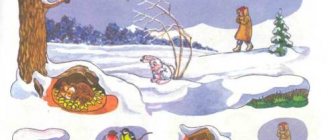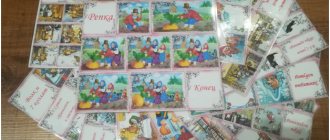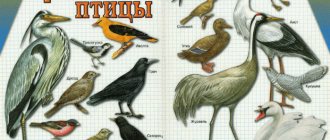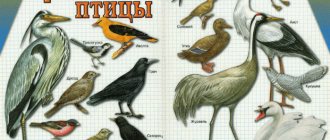Summary of an open lesson in a preparatory speech therapy group on the topic “Migratory Birds”
Goal : generalize children's knowledge about migratory birds.
OO tasks:
NGO “Cognitive Development” Expand and enrich children’s knowledge about migratory birds and their nesting characteristics; develop and consolidate rules of behavior in nature.
NGO “Social and Communicative Development” To develop the ability to work together, to cultivate an attentive and caring attitude towards living things (birds).
OO “Physical Development” Strengthen the ability to act on a signal. Ensure maximum physical activity during educational activities (carrying out actions according to instructions).
OO “Speech Development” Develop coherent speech on the topic, improve sound pronunciation and grammatical structure (inflection, use of prepositional-case forms). Replenish the nominative (names of migratory birds: stork, thrush, lark, swallow, warbler, wagtail, rook, starling, chaffinch, robin, warbler, wheatear) and predicative (sing, fly, curl, hatch, hatch, build, peck) children's vocabulary .
NGO “Artistic and Aesthetic Development” To develop an interest in music in nature through listening to recordings of bird voices.
Preliminary work : conversations showing illustrations of migratory birds and familiarization with the features of their nesting; reading fiction on the topic, becoming familiar with the rules of behavior in nature.
Equipment : recording of birdsong, 2 easels, pointer, ball, diagrams “Change the word”, “Where is the object?”, inscriptions of the names of birds, divided into two parts; signs for physical minutes: “Park”, “Street”, “Birch”, “Glade”, “Fields”; box with branches, leaves, dry grass, straw, stones, feathers, moss, clay.
Progress:
1. Organizational moment.
Children in a circle on the carpet. The sound of birds singing. P.: Guys, what is this? D: The birds are singing. P: Why do they sing? D.: Because spring came, it became warm, and the birds returned to their native lands. P: Right, but why did the birds return now, in the spring? D.: Because insects appear and the birds will have food. P: Guys, what migratory birds do you know? Children's answers. P.: Guys, today Vanya brought an interesting box to kindergarten, let's look into it! Children and their teacher look at the contents of the box. P.: Who will need all this? D.: Birds! P.: That’s right, but we will find out exactly how during our conversation.
2. D/games “Change the word.”
P.: To distribute the contents of the box to the birds, we will practice changing the names of the birds. Children (2-3 people) change the word by case, following the pattern: for example, there is a nightingale, there is no nightingale, I go to the nightingale, I see the nightingale, I think about the nightingale, I admire the nightingale. P.: Well done, let's play again? Children stand in a circle on the carpet. P.: Catch the ball and answer, Answer and don’t yawn! What can a bird do?
3. D/game “What can a bird do?”
D.: flies, sings, howls, hatches, lays, hatches, builds, lines, insulates, pecks, jumps, etc.
4. D/exercise "Where is the bird?"
P.: Let's play with the starling and his house - what is it called? D.: Birdhouse. P.: Name where the starling is relative to the birdhouse, the rook relative to the nest, using our diagram: P.: Are you probably tired? And so everyone stood up! What birds are called the harbingers of spring? D.: Rooks. P.: We turn into rooks and “fly” around the group, reading the signs and listening to my instructions.
5. Phys. just a minute.
There are signs hanging around the group: Park, Street, Birch, Glade, Fields. The teacher guides the children by saying phrases, and the children follow the route and follow the instructions:
- In early spring, the rooks returned to the Park.
- The Street became noisy from the loud cry of the rooks - “rook!, rook!”
- At the top of the Birch, rooks are repairing last year's nests.
- In the spacious Glade, rooks and rooks collect dry grass to line their nests.
- In the plowed fields, rooks collect beetles, larvae, and worms.
P.: We rested, flew around and collected the names of the birds into words.
6. D/exercise “Put the word together.”
Look, on the easels there is the beginning of the word and the end, you collect the parts of the word, and read the name of the bird. Children approach the easels and put the syllables into words: Pe - night, a - ist, ka - menka, shake - tail, mal - new, zhavo - ronok, slav - ka, chill - face, las - dot, squaw - retz. P.: What birds flew to us? Children read the resulting words. P.: It’s time to help the birds, let’s look at the box and give each bird something that will be useful for building a nest.
7. D/game “Who needs a gift?”
Children take out one object each and “distribute” it to the birds, explaining their choice: Stones - to the wheatear, clay - to the swallow, branches - to the stork, feathers - to the warbler, grass, straw - to the lark, warbler, moss - to the chaffinch, leaves - to the starling, robin, wagtail .
8. Results.
The sound of birds singing. Children are sitting on the carpet. P: How joyfully the birds sing! Tell me, what are they happy about? D.: They returned to their nests, they have everything to repair and build their homes. P.: That’s right, the birds thank you, guys, and are always happy to see you in forests, parks, squares, you just need to remember the rules of behavior. Do you know them? D.: You cannot make noise, shout, tear leaves, flowers, break branches, destroy nests, etc. P.: You are right, and our journey with the birds has come to an end, well done!
Ivanova Anna Vladimirovna Teacher-speech therapist, MDOU "Kindergarten No. 176", Yaroslavl



